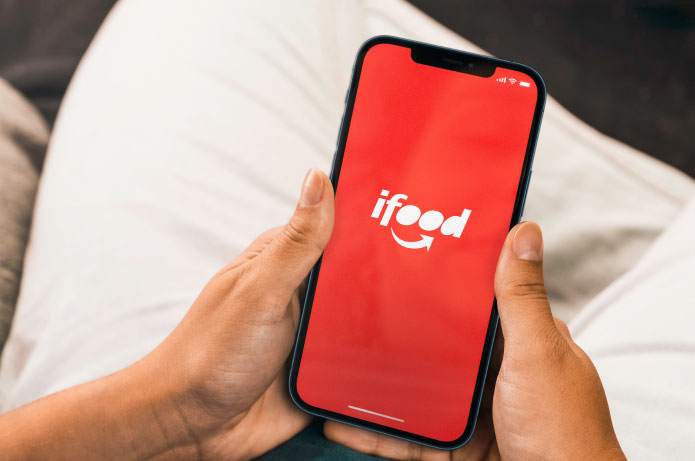O iFood, empresa brasileira de tecnologia, lança nesta terça-feira (02) a Retrospectiva iFood 2025 para seus 60 milhões de usuários, revelando os pratos, restaurantes e demais itens que mais consumiram durante o ano. Com o tema “O melhor do iFood é o brasileiro. E ser brasileiro”, a seleção individual, revela o singular modo de consumir delivery que o povo brasileiro possui, trazendo curiosidades apresentadas em 15 stories, com a oportunidade de compartilhar nas redes sociais. A retrospectiva estará disponível até 31 de dezembro.
Com 60 milhões de usuários e 160 milhões de pedidos mensais, o iFood celebra o jeito brasileiro de pedir iFood e busca criar conexão e engajamento com seu público, personalizando a experiência de cada usuário de acordo com seu histórico de pedidos – seja em restaurantes, mercados, farmácias ou pet shops. Pelo aplicativo, cada pessoa poderá obter informações como o tempo que passou no iFood, total de pedidos, o primeiro pedido do ano, qual foi o prato mais pedido, além de exibir os tipos de refeição e de restaurantes que mais foram escolhidos para estarem em momentos especiais de apreciação de comida boa em 2025. A seleção ainda exibirá a categoria mais consumida depois de Restaurantes – se Mercado, Farmácia, Pet ou Shopping.
“A retrospectiva do iFood é um momento muito aguardado pelos nossos consumidores e representa uma verdadeira celebração do relacionamento entre nossa marca e os milhões de brasileiros que escolhem o iFood como seu delivery preferido em todos os momentos — seja para pedir aquela refeição especial de sábado à noite, fazer compras no supermercado ou pedir um item na farmácia. Como empresa brasileira, temos orgulho do nosso papel de impacto positivo no país. Em 2025, escolhemos a brasilidade como tema central da nossa Retrospectiva, celebrando uma verdade que nos define: do Brasil, o iFood entende — e sabemos como ninguém o jeito brasileiro de pedir delivery”, afirma Ana Gabriela Lopes, Vice-presidente de Marketing e Comunicação do iFood.
Novidades na edição deste ano
A versão da Retrospectiva iFood em 2025 vem com novidades. Além do foco total no histórico individual, o iFood traz recursos inéditos que exibem os diferentes jeitos de pedir delivery com base no dia da semana e no turno favorito do usuário — seja café da manhã, almoço, lanche, jantar ou madrugada. Cada cliente terá acesso a uma tela exclusiva simulando ‘panos de prato’, com estampas que trazem justificativas divertidas para se dar o ‘luxo’ de pedir um iFood naquele momento.
As artes são protagonizadas por ícones carismáticos, como a capivara e o cachorro vira-lata caramelo, acompanhados de frases que geram identificação imediata, como ‘Meu hobby é fingir que vou cozinhar’ ou ‘Jantar de adulto: leve, rápido e sem drama’.
O Clube iFood, programa de benefícios exclusivos da plataforma, também está contemplado na retrospectiva: cada assinante poderá saber o quanto economizou no ano e também entender sua posição no ranking dos que mais ganharam descontos pelo clube de assinatura.
O mais pedidos de 2025
O iFood também analisou quais foram as categorias dos itens que o brasileiro mais colocou no prato (ou na sacola) este ano e a preferência pela conveniência é inegável: a categoria de Lanches liderou o ranking com folga, acumulando 253 milhões de pedidos – um volume que supera, sozinho, a soma do segundo e terceiro lugares. No entanto, a tradição se mantém forte: a culinária Brasileira garantiu a vice-liderança com quase 118 milhões de escolhas, seguida pela paixão nacional pela Pizza (92 milhões). O ano também consolidou as tradicionais Marmitas (52 milhões) e da comida Japonesa (50 milhões).
A análise dos horários confirma que o jantar é o ‘horário nobre’ do delivery no Brasil. Com um volume massivo de 487.7 milhões de pedidos, as refeições noturnas quase dobram o desempenho do almoço, que registrou 278 milhões de entregas – um dado que reforça o aplicativo tanto como solução para o fim do dia quanto para a otimização do tempo durante o expediente. O intervalo da tarde também se mostrou um momento chave de consumo, com o Lanche da Tarde somando 71.7 milhões de pedidos. Curiosamente, as extremidades do dia mostram um equilíbrio interessante: o Café da Manhã (23,5 milhões) supera ligeiramente a Madrugada (22,3 milhões), provando que a conveniência é requisitada do primeiro café ao último snack da noite.
Como acessar?
Para cada pessoa acessar a sua Retrospectiva iFood 2025, basta:
- Abrir o aplicativo iFood, disponível para Android e iOS;
- Localizar o ícone com número “25”, na grade de categorias destacadas no topo da página inicial do app. Ou;
- Localizar o banner da Retrospectiva iFood 2025 no topo e meio da página
Ao iniciar a experiência, arrastar para o lado e se divertir com os resultados. Cada lista poderá ser compartilhada pelas redes sociais.
Além dos consumidores, os restaurantes parceiros e entregadores também terão acesso às suas respectivas Retrospectivas iFood 2025, dentro dos app dedicados. As retrospectivas podem ser acessadas no app do parceiro a partir do dia 3/12 pelos restaurantes e no dia 10/12 no app dos entregadores.


